Tag: Neuse Riverkeeper
Kayak-Canoe Raffle Rules and Conditions
March 21, 2023
Kayak-Canoe Raffle Rules and Conditions
Sound Rivers, Inc
Official Kayak/Canoe Raffle Rules
September – October 2016
Raffle Item: Wood kayak/canoe handcrafted by Ed Rhine
Benefitting: Sound Rivers
Price of raffle ticket: $20.00
Odds of winning: Odds of winning depends upon the number of raffle tickets sold. No more than 500 raffle tickets will be sold.
Expected Drawing Date: October 22, 2016
Method by which the winners will be determined and the raffle will be conducted:
The drawing for the kayak-canoe is planned to occur at the Washington NC Dragon Boat event on October 22 following conclusion of the races, unless insufficient number of tickets have been sold. Winners need not be present to win. The winner will be determined by a random drawing of stubs from purchased tickets. If not present at the time of the drawing, the winner will be notified via contact information supplied during ticket purchase. The kayak/canoe is provided without warranty and will be available for pick-up in Washington, NC or Chocowinity, NC. Prize winner will be responsible for all applicable shipping costs if shipment is desired.
Must be 18 years or older to purchase raffle tickets or claim raffle prize.
Contingency plan for the raffle if drawing is not conducted as planned:
If the Dragon Boat event on October 22, 2016 is cancelled for any reason, or the raffle cannot be conducted on that date as planned, the raffle will be completed on the next available business day at noon in Sound Rivers’ offices. If the Sound Rivers offices are not available due to some misfortune, another location in Washington, NC will be selected and the drawing held their on the first available business day following October 22, 2016.
If fewer than 250 tickets have been sold by October 22, 2016, drawing may be postponed for up to one month. If the drawing is delayed, drawing will be held in the Sound Rivers’ offices or other suitable location in Washington, NC or Chocowinity, NC at a time and date to be communicated at least 48 hours in advance on the Sound Rivers website and Facebook page.
No cash equivalent available:
No cash equivalent is available in lieu of the kayak/canoe. If the kayak/canoe has been damaged or destroyed before the drawing or prior to pick-up by or shipment to the winner, the winner will be entitled to a cash settlement of $1,500.
Redemption Claim period:
Winner will have thirty (30) days from the notification of winning to confirm his/her address and his/her acceptance of the prize. If we are unable to contact winner within thirty (30) days from the drawing date of the raffle, or if the selected winner declines acceptance of the prize, an alternate winner will be chosen from the remaining entries.
If arrangements to pick up the prize or to have it shipped at the prizewinner’s expense cannot be made with the winner within sixty (60) days of the drawing, Sound Rivers shall conduct another drawing using the original pool of ticket entries. This process will be repeated until a winner is located and the prize accepted.
Statement of eligibility, release of liability and publicity release required:
As a condition of being awarded the prize, winner will be required to execute an affidavit of eligibility, liability waiver and sign a publicity release. If the winner is unwilling to sign the affidavit, the winner will forfeit the prize and a new winner will be drawn from remaining entries.
Refund Policy:
No ticket refunds will be given.
Effective date of these rules: August 31, 2016
Ticket purchase locations:
Tickets are available at Cotton Patch Landing, 2018 Cotton Patch Rd, Chocowinity, NC 27817 and in the Sound Rivers, Inc. office at 108 Gladden St., Washington, NC 27889. Additional raffle ticket outlets may be added.
Tickets are also being sold by various individuals working to SAVE BLOUNTS CREEK.
More pictures showing construction of the kayak/canoe and information about the threat to Blounts Creek are available at www.facebook.com/saveblountscreeknc and at www.soundrivers.org.
Landscaping for Clean Water
March 21, 2023
Polluted Stormwater Runoff

When rain falls in a natural setting, almost all stormwater infiltrates the soils and groundwater or is taken up by vegetation. But when land is developed, the impervious cover (roads, rooftops, driveways, parking lots) increases the volume of stormwater that is not absorbed by the land and accelerates the transport of stormwater across the surface of the land. As impervious cover increases, so does the volume and velocity of contaminated surface runoff into streams, lakes and sounds.
Polluted stormwater runoff, including sediment from poorly maintained construction sites, is the number one reason for poor water quality in North Carolina. Sediment can cause severe problems for creeks, rivers and estuaries on which we depend for our drinking water, recreation, wildlife habitat and fishing. Stormwater is one of the main causes of pollution in the Neuse and Tar-Pamlico Rivers.
Stormwater pollution results in a multitude of economic losses. Sediment, toxic pollutants and pathogens in stormwater leads to poor quality fish catch and financial losses for the commercial and recreational fishing industries. Contaminated beaches result in medical expenses to treating water related illness and the beach community suffers from losses in sales and services. Stormwater pollution leads to increased water treatment costs. Increased stormwater runoff creates significant flood damage repair costs and dredging costs. Measures to decrease stormwater impacts can significantly increase property values.
Landscaping for Water Quality
 In order to deal with the increased problems from polluted stormwater runoff, Sound Rivers began a restoration program in 2010 to implement on-the-ground projects to restore water quality.
In order to deal with the increased problems from polluted stormwater runoff, Sound Rivers began a restoration program in 2010 to implement on-the-ground projects to restore water quality.
The photo on the left is a created stormwater wetland constructed in 2015 at Edgecombe Community College in Tarboro. The wetland treats stormwater from the campus main parking areas. Two more created wetlands were built, along with a rain garden and bioretention cell. Click to view image of educational sign.
A similar project has been completed on East Carolina University’s campus in Greenville, NC. Sound  Rivers in cooperation with ECU built one created wetland, three bioretention cells (engineered rain gardens) and installed permeable pavement on the campus to improve Green Mill Run, a stream that runs through the heart of the city and the campus.
Rivers in cooperation with ECU built one created wetland, three bioretention cells (engineered rain gardens) and installed permeable pavement on the campus to improve Green Mill Run, a stream that runs through the heart of the city and the campus.
The program expanded in 2017 and Sound Rivers is currently working with more than 20 community college, private college and K-12 campuses to plan and construct stormwater projects.
What Can You Do? Everyone can do their part to reducing polluted stormwater runoff. Limit your impact by:
- Applying fertilizers and pesticides sparingly and do not apply before rain events.
- Test soil first to determine fertilization needs. Tips.
- Reduce bacteria by picking up after your pets and dispose of the waste properly.
- Wash your car on your lawn where the chemicals and soap can be absorbed and filtered by the soil instead of washing directly into a stream.
- Dispose of lawn clippings in a compost pile.
- Harvest and reuse rain water via rain gardens, rain barrels and cisterns.
- Preserve and plant trees.
- Maintain your septic tank! Tips.
Stormwater and Your Rain Garden
More Information
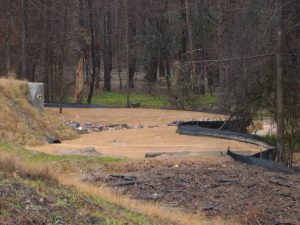
Landscaping for Clean Water
March 21, 2023
Polluted Stormwater Runoff
When rain falls in a natural setting, almost all stormwater infiltrates the soils and groundwater or is taken up by vegetation. But when land is developed, the impervious cover (roads, rooftops, driveways, parking lots) increases the volume of stormwater that is not absorbed by the land and accelerates the transport of stormwater across the surface of the land. As impervious cover increases, so does the volume and velocity of contaminated surface runoff into streams, lakes and sounds.
Polluted stormwater runoff, including sediment from poorly maintained construction sites, is the number one reason for poor water quality in North Carolina. Sediment can cause severe problems for creeks, rivers and estuaries on which we depend for our drinking water, recreation, wildlife habitat and fishing. Stormwater is one of the main causes of pollution in the Neuse and Tar-Pamlico Rivers.
Stormwater pollution results in a multitude of economic losses. Sediment, toxic pollutants and pathogens in stormwater leads to poor quality fish catch and financial losses for the commercial and recreational fishing industries. Contaminated beaches result in medical expenses to treating water related illness and the beach community suffers from losses in sales and services. Stormwater pollution leads to increased water treatment costs. Increased stormwater runoff creates significant flood damage repair costs and dredging costs. Measures to decrease stormwater impacts can significantly increase property values.
Landscaping for Water Quality
In order to deal with the increased problems from polluted stormwater runoff, Sound Rivers began a restoration program in 2010 to implement on-the-ground projects to restore water quality.
 The photo on the left is a created stormwater wetland constructed in 2015 at Edgecombe Community College in Tarboro. The wetland treats stormwater from the campus main parking areas. Two more created wetlands along with a rain garden and bioretention cell have also been built, treating more than 90% of the campus. Click to view image of educational sign.
The photo on the left is a created stormwater wetland constructed in 2015 at Edgecombe Community College in Tarboro. The wetland treats stormwater from the campus main parking areas. Two more created wetlands along with a rain garden and bioretention cell have also been built, treating more than 90% of the campus. Click to view image of educational sign.
A similar project has begun on East Carolina University’s campus in Greenville, NC. One created wetland and three rain gardens have been constructed to improve Green Mill Run that runs through the heart of the city and the campus.
What Can You Do? Everyone can do their part to reducing polluted stormwater runoff. Limit your impact by:
- Applying fertilizers and pesticides sparingly and do not apply before rain events.
- Test soil first to determine fertilization needs. Tips.
- Reduce bacteria by picking up after your pets and dispose of the waste properly.
- Wash your car on your lawn where the chemicals and soap can be absorbed and filtered by the soil instead of washing directly into a stream.
- Dispose of lawn clippings in a compost pile.
- Harvest and reuse rain water via rain gardens, rain barrels and cisterns.
- Preserve and plant trees.
- Maintain your septic tank! Tips.
Volunteer
March 21, 2023
Volunteer
Interested in volunteering for Clean Water? Great!
Below are descriptions of some of our volunteer opportunities; fill out the form and let us know what you’re interested in!
Trash Trap Volunteer
Trash Traps are passive litter traps that will float on the surface of the creeks, are attached to the banks, and capture all the floating trash before it ends up making its way down to the Pamlico and Neuse rivers. Once the trash is captured in the trap, it needs to be manually removed and sorted. We are looking for volunteers in Washington and New Bern:
Trash Trap Scouter
We’ve never done this before and don’t know how quickly the trap will fill up with trash. It would be great to have a few folks who can be our eyes on the trout, to swing by once a week and after a rain storm to snap a few photos and see how full the trap is, and if it’s in need of a clean out.
Event Volunteer
Throughout the year Sound Rivers has events all over Eastern NC – from our large fundraiser, the Oyster Roast a, to the educational Kids River Fest, to small screenings and fun get-togethers. Let us know if you want to volunteer for a specific event (mention it in the “comments” section on the form below.)
Clean-Up Crew
Willing to wade into the creek and pull trash out of the trap (we can provide waders and gloves).
Trash Auditors
For those who don’t want to get in the creek, we need help tallying up the trash.
Office/Mailing Volunteer
We have some opportunities in our Washington, NC or New Bern, NC offices for stuffing envelopes, data entry, office organization, and more! For this volunteer opportunity, we are looking for volunteers available on weekdays.
Water Cleanups – Organizer
We do cleanups throughout the year, typically organized by our Riverkeepers, but the more we can do, the better the waters will be! Are you interested in taking a leadership role and helping to organize and run your own cleanup, with support from Sound Rivers’ staff? This is the opportunity for you! (Ages 18+ please.)
Water Quality Monitoring
Our greatest need for volunteers is in the summer months during our Swim Guide program. Swim Guide is weekly samples collected by volunteers from Memorial Day to Labor Day weekend. Throughout the year we need volunteers less frequently, but on weekdays. If you have daytime availability Monday through Thursday, please let us know in the comments of the form below so we can contact you when we need volunteers. Training and materials provided!
Water Trail Steward
Interested in making a significant impact on public access to waterways, by taking on a leadership role at Sound Rivers? Water Trail Stewards will help manage our Tar-Pamlico Water Trail, regularly inspecting the camping platforms for needed repairs, and helping to keep them in good working order.
Don’t see what you’re looking for but still want to volunteer?
Go ahead and fill out the form below and let us know what your thoughts are!
Clean Water Act
March 21, 2023
Clean Water Act
Updates
The deadline for getting comments to EPA and the Army Corps urging that they halt plans to gut the Clean Water Act has passed, but things aren’t over yet. Stay tuned for more ways you can be involved soon!
NC Wrote Strong Comments to EPA Opposing Rollbacks: The North Carolina Department of Environmental Quality and Department of Justice sent excellent comments in to the federal agencies opposing the rollbacks.
Write a letter to the editor: Though the comment period is over, as EPA analyzes the comments received it is still important to show visible public support for clean water, one way to do this is to write a letter to the editor in your local paper. You can find some information on how to do that here.

EPA’s Waters of the United States Rule Aims to Gut Protections for Your Streams and Wetlands
Despite the fundamental necessity of clean water, politicians in Washington are trying to dismantle the Clean Water Act, which has kept our nation’s waters clean for nearly 50 years. This bedrock environmental safeguard is a central tool used by state and local governments to shield and protect clean water needed for healthy communities and families. Without it, polluted waters would threaten North Carolina’s local economies, communities, and way of life.
Allowing open dumping into upstream waters spells trouble for everyone downstream. Pollution dumped by industry flows from smaller streams into our rivers and lakes, across state lines and downriver, contaminating waters used by families and communities for drinking and recreation. The best way to protect clean water is to stop harmful pollution at its source, before it reaches our waterways.
Under the proposal by the administration and supported by industrial polluters, more than 49,000 miles of North Carolina’s streams and millions of acres of wetlands will again be at risk from pollution and destruction. At least fifty percent of North Carolinians get their drinking water from sources that rely on small streams that may lose critical Clean Water Act protections under the administration’s proposal. More than 7,000 miles of streams that feed into North Carolina’s drinking water sources would be at risk for pollution if the Clean Water Act is rolled back as the administration plans. Millions of acres of wetlands that provide flood protection, filter pollution, and provide essential wildlife habitat are at risk if the federal government moves forward with its plan.

Your voice will is critical to ensure North Carolina’s waterways are protected so please stay tuned on how you can help fight for our waterways.
More Information & Resources
Southern Environmental Law Center Fact Sheet
New York Times: Trump Rule Would Limit E.P.A.’s Control Over Water Pollution
The Intercept: EPA’s Own Data Refutes Justification for Clean Water Act Rollback
EPA fact sheet on major changes
North Carolina DEQ and DOJ comments regarding the rollback proposal
Adopt a Swim Guide Site
March 21, 2023
Adopt a Swim Guide Site
Click below to donate today!
El Programa de Swim Guide
March 21, 2023
El Programa de Swim Guide
Get your weekly water quality alerts here!
swim guide here
Want to get weekly water quality alerts straight to your phone? Text “SWIM” to 833-686-5322!
IN ENGLISH
Los encargados del río Neuse y Tar-Pamlico de Sound Rivers, trabajan con pasantes de verano y voluntarios para monitorear la calidad de agua en varios sitos en las cuencas de Neuse y Tar-Pamlico. Se toman muestras semanales en nuestros sitios, las cuales comenzamos desde finales de Mayo hasta el fin de Agosto. Monitoreamos nuestros sitios por la bacteria E. coli en las aguas dulces y por la bacteria enterococcus en el agua salada.
Tan pronto como estén disponibles los resultados de nuestro monitoreo, se publicarán aquí, en el sitio de web de Swim Guide, en la aplicación de smartphone, en nuestra página de Facebook, y se será anunciado por Public Radio East entre las 4 y las 6 de la tarde cada viernes. También, pueda recibir alertas de texto semanal durante el verano (envíe el mensaje NADAR a 833-686-5322 para formar parte de nuestra lista de alertas de texto).
RESULTADOS POR EL
el 30 de agosto 2024
¡Es el final de la temporada 2024 de Swim Guide!
La temporada 2025 de pruebas semanales de calidad del agua comenzará nuevamente el fin de semana del Día de los Caídos de 2025. Hasta entonces, entregaremos resultados de sitios selectos en Neuse y Tar-Pamlico mensualmente. ¡Sigue revisando!
EN EL RIO UPPER NEUSE
Todo los sitios pasaron esta semana. Beaver Dam, Barton Creek boat ramp, Poole Road y el Neuse Golf Club in Clayton no fueron probados.
EN EL RIO LOWER NEUSE
Dos sitios no pasaron esta semana: Black Beard Sailing Club en Upper Broad Creek y Slocum Creek en Havelock.
Spring Garden boat ramp y Rice Creek no fueron probados esta semana.
EN EL RIO TAR-PAMLICO
Un sitio no paso esta semana: Cotton Patch Landing en Blounts Creek.
Bonner’s Point y Plum Point en Bath, y Wright’s Creek en Belhaven no fueron probados.
Nuestra Misión
Monitorear y proteger las cuencas de los ríos Neuse y Tar-Pamlico que abarcan casi un cuarto de Carolina del Norte, y preservar la salud y belleza de la cuenca fluvial mediante justicia ambiental.


Criterios de Calidad del Agua
Los criterios de calidad de agua para la recreación de contacto usados por Sound Rivers vienen de Carolina del Norte y del EPA (Agencia de Protección Ambiental). Cuando la última muestra de un sitio presenta niveles de bacteria saludables, lo marcamos verde. Si la última muestra de un sitio no cumple con los criterios de calidad del agua, o presenta niveles de bacteria no saludables, lo marcamos con rojo. Cuando no hay información disponible o no hay resultados actuales, marcamos el sitio con gris.
E. coli, un tipo de bacteria que se encuentra en el intestino de personas y otros animales, es un buen indicador de contaminación fecal reciente. Aunque varios tipos de estas bacterias son inofensivas, algunos tipos nos pueden causar enfermedades, o causar problemas gastrointestinales más graves en grupos de personas más sensitivos.
El Programa de Calidad de Agua Recreativa de la División de Pesquerías Marinas, bajo el Departamento de Calidad Ambiental de Carolina del Norte, conduce pruebas adicionales en la región. Los resultados de estas pruebas son incorporados en los sitios listados en el sitio de web de Swim Guide y en la aplicación de teléfono celular.
Muchísimas gracias a nuestros patrocinadores, los cuales nos ayudan a traer
el programa Swim Guide para ustedes este verano!



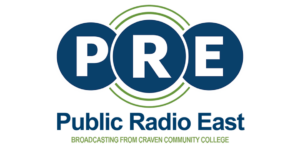
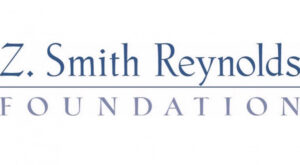



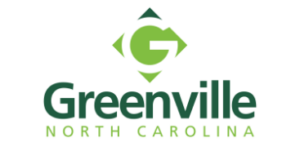




Our History: Full Story
March 20, 2023
Our History: Full Story
VOICE FOR THE RIVER
It’s a clear, crisp November day in eastern North Carolina, and high above the lowlands surrounding the Trent and Neuse rivers, Samantha Krop is on a mission.
Through the window of a twin-propeller Cessna, Krop points out a massive, covered lagoon — part of a biogas-harnessing industrial swine facility — that ruptured and spilled millions of gallons of foam made from decomposing waste, dead hogs and expired deli meats over the land and into Nahunta Swamp in May of 2022.
“This facility has a clear history of illegally discharging waste, and DEQ knew it. They failed to take meaningful action to prevent a major pollution event from happening, and failed to adequately notify the public,” Krop says. “This is people’s drinking water; it’s the water they swim in; it’s the water they fish from — and the agency responsible for protecting it isn’t doing its job.”

Krop is the Neuse Riverkeeper, and she — like her counterpart on the Tar-Pamlico, Katey Zimmerman — regularly takes to the waterways and skies to surveil potential sources of water pollution. They’re the latest crew of Riverkeepers, carrying on a fight for clean water that’s been waged for decades. That battle began when two communities, separated by many miles of the Coastal Plain, took the health of the rivers in their own hands, forming grassroots organizations serving as watchdogs for the waterways. Today, they are Sound Rivers, a merger of two of the oldest environmental nonprofits in North Carolina, now celebrating more than four decades of being the voice for our rivers.
SOUND RIVERS
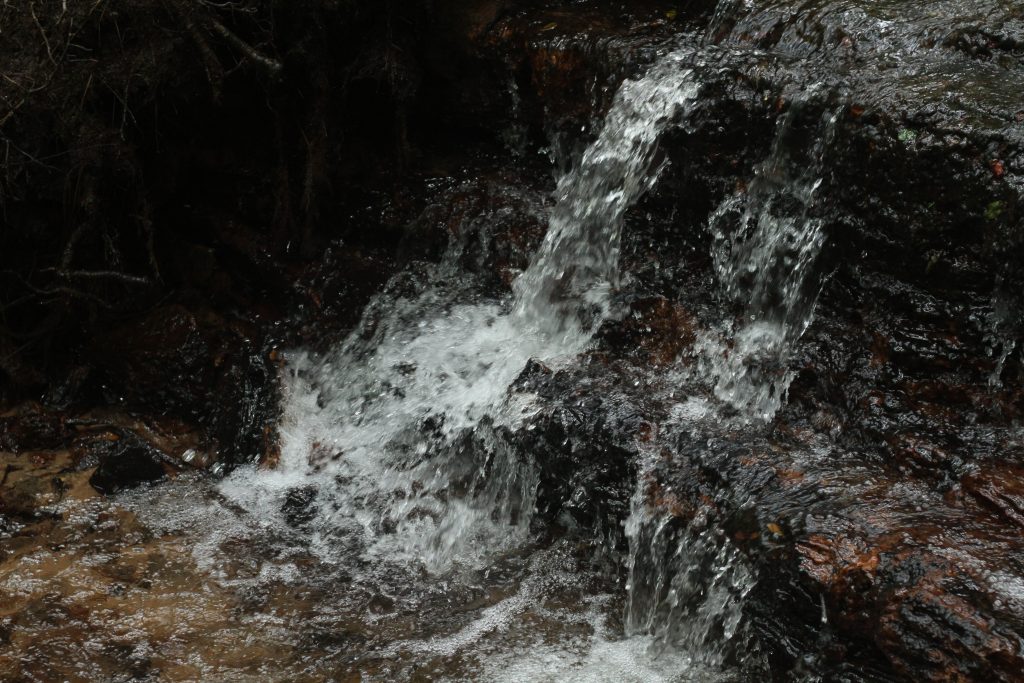
Forty years ago, a fundamental change had taken place in the Neuse and Tar-Pamlico rivers. Fish and crab, so abundant in previous decades, had declined. Forests of sea grass had disappeared, seemingly overnight.
“I grew up here, and I was born in ’48. I lived on the river, so I spent my childhood in the river. It was a blissfully ignorant time, an innocent time. We had no environmental concerns,” said Linda Boyer, who grew up at Summer Haven, just east of Washington. “Then, gradually, the area became more developed. We had a lot more houses on the river. We had a lot more serious, big farming. We had industry come in. Gradually the river became degraded because of all those factors, you know, slowly trickling down into the river. People started noticing fewer fish, fewer crabs; we started getting crab diseases. The future of the river — people started getting concerned about what would happen if there was no regulation.”
The change was not going unnoticed further south, on the Neuse.
“Back then, we swam; we didn’t get infections. We fished, we floundered, just really enjoyed it and didn’t think particularly of what the water might contain,” said Grace Evans, a lifelong sailor who first sailed the Neuse in 1960, then made the area her permanent home in 1972. “The first thing that we noticed back then was that there was a lot of trash, whether it was beer cans or just whatever people had thrown overboard — washing machines, toilets, hunters throwing deer carcasses in the creek. There was a lot of litter.”
But as massive fish kills began to occur regularly, clogging beaches and waterways with the dead and dying, a movement was started.
THE EARLY DAYS: ON THE PAMLICO
“It’s interesting to see the evolution of the organization, how we got from the kitchen table to the organization we have now. At the start, there was no staff, and I don’t know when or where we decided to call ourselves a board — that was a little presumptive on our part — but we just did what we needed to do to get things done,” laughed Dr. Ernie Larkin, one of the founders of Pamlico-Tar River Foundation.
PTRF, indeed, made its start around the kitchen table in the Summer Haven home of Ross and Linda Boyer.
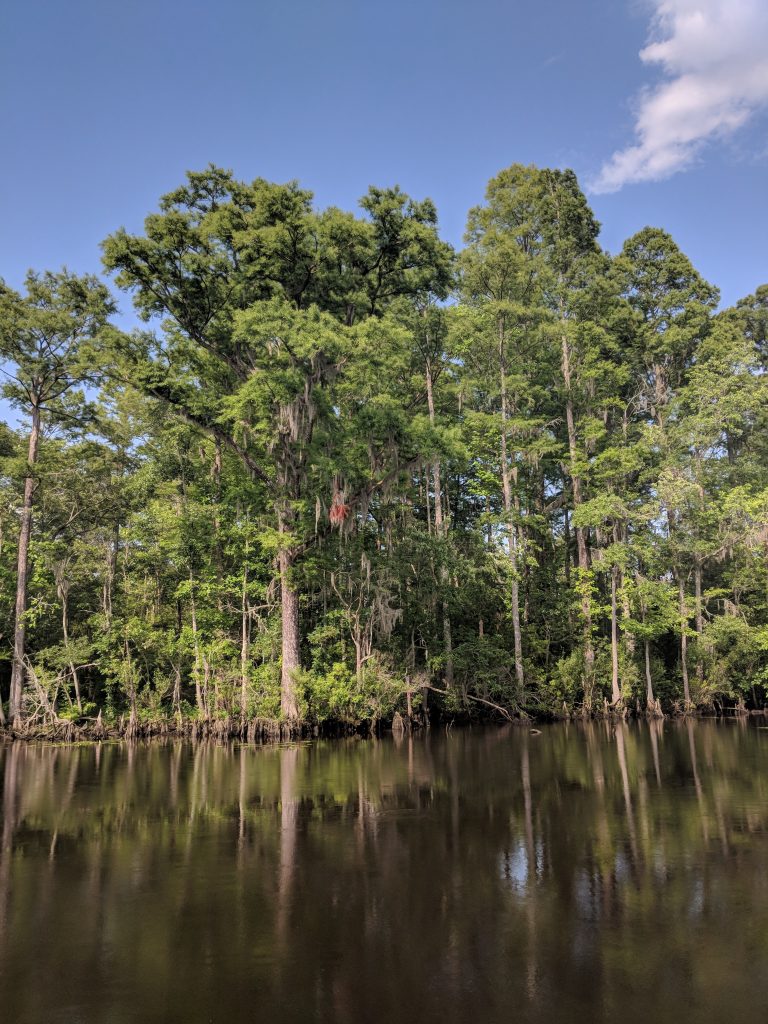
“What were those early meetings like? Very long,” Boyer laughed. “We had two babies, and I would put the babies to bed, and I would sit in on the meetings. There was a lot to talk about, a lot to learn, a lot to try to come to grips with.”
Under the leadership of Dick Leach and Billy Jackson, seated at that table were long-time Summer Haven residents and other river-lovers determined to put a stop to the river’s decline. The first order of business was to sway Beaufort County commissioners from approving a plan to allow Texasgulf Chemicals Company to mine the riverbed at its Aurora site — and they did.
Throughout the remaining decade, Pamlico-Tar River Foundation led public resistance to many proposals that would have damaged the river, wetlands and more, and worked with Texasgulf, the state and other environmental agencies to resolve another ongoing issue at the Aurora facility: nutrient pollution. Nutrient may seem like an innocuous term, but when excessive nutrients are dumped into waterways, they feed algae, which leads to massive algal blooms and de-oxygenated water that kills fish in equally massive quantities.
“Some of it was just direct negotiation with (Texasgulf). I remember just going down there and talking to those folks and hearing what they had to say. And they did something; they changed their process with wastewater to recycle it,” Larkin said. “They were dealing with a lot of phosphates, a lot of nutrients, that they were putting in the water, and they knew that and did something about it.”
1989 was a turning point, however. It was the year the Tar-Pamlico River Basin was declared Nutrient Sensitive Waters by the Division of Environmental Management — those responsible for nutrient overloads needed to stop. It was also the year the Division of Marine Fisheries declared the river “commercially dead,” so decimated was the commercial fishing and crabbing industry.
On the Neuse, things were no better.
THE EARLY DAYS: ON THE NEUSE
“As a kid, I always wanted to be fisherman, but my mother and father talked me out of it,” said Rick Dove.
Dove got his chance, however, after earning a law degree, then getting a draft notice for Vietnam that resulted in a 20-plus-year career in the U.S. Marine Corps.
“I came here in 1975; the Marine Corps brought me here. When I walked out the gate for the last time, I traded my spit-shined shoes and put on the dirtiest clothes I could find and became a commercial fisherman,” Dove said. “Things were great until about 1990.”
That’s when the catch from the Neuse became riddled with sores; Dove and his son, Todd, who fished with him, had them too.
“I wouldn’t eat the fish, so I decided couldn’t sell them either,” Dove said.
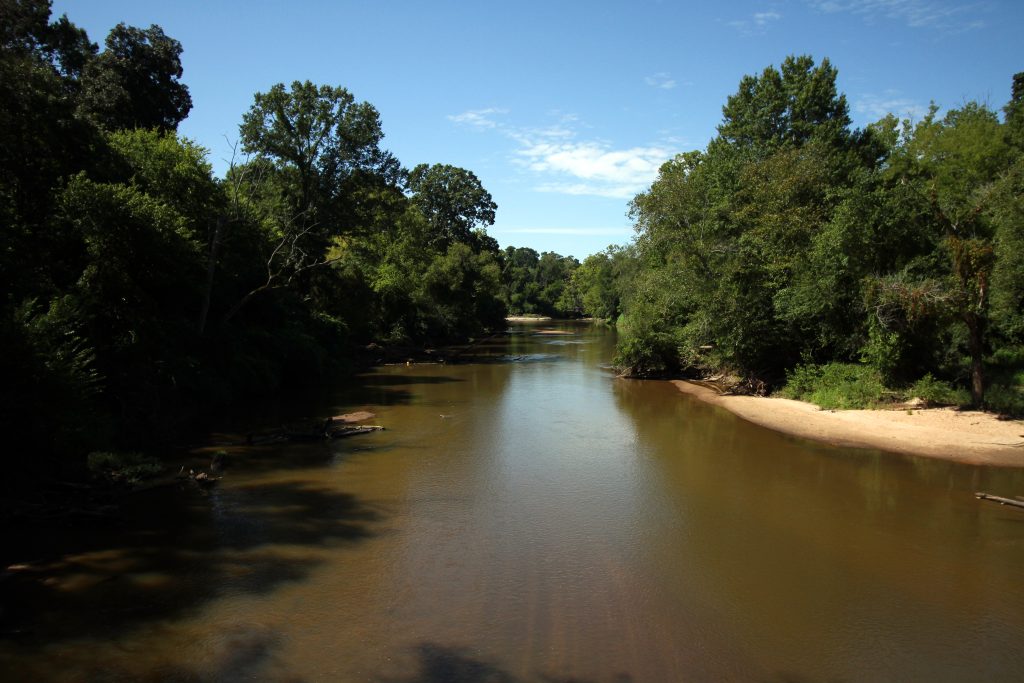
Dove hung up his dirtiest clothes, went back to practicing law and found a new calling when he was hired as the Neuse Riverkeeper at the behest of Evans and other members of the Neuse River Foundation. At that point, NRF had been successful in its bid for a statewide ban on cleaning products containing phosphorous, which entered the waterways through sewage treatment plants, much to the detriment of aquatic life.
When Dove came aboard, he put his law degree to use again, this time going after those polluting the river, directly.
“We sued wastewater treatment plants and hog farms. Our docket had 20 cases on it, all the time. We were in court a good bit of the time, but most of our cases were settled out of court,” Dove said.
The Neuse River Foundation grew from 70 members to more than 2,000. The Neuse River had gotten a bad reputation, devastating both tourism and the housing market, and disparate interests banded together to do something about it. Hundreds of volunteers patrolled and sampled the water at points from the lower Neuse up to Raleigh, and local pilots volunteered their planes to get a bird’s-eye view of pollution sources.
A designated force of creek-keepers took an active role in tracking salinity, turbidity and oxygen levels in tributaries.
“It was a very active time in the ’90s. We got pretty good results with all the screaming and yelling we were doing about the health of the river,” Dove said.
Merging of Minds
Decades of advances in water quality were offset by steps backward, even as much-loved fundraisers to fund the work of the organizations drew large crowds of river-lovers — the PTRF Oyster Roast on the grounds of the Civic Center in Washington and NRF’s Taste of Coastal Carolina in New Bern. Then, in 2015, the voice for the river became louder when the Pamlico-Tar River Foundation and Neuse River Foundation merged to become a powerful advocate for protection of the watersheds covering nearly a quarter of the state of North Carolina.
“Sound Rivers has become a respected environmental voice,” Boyer said. “It’s always had integrity, and it’s always had one goal, which is to preserve the health of the river.”
Results included injunctions against industrial hog farms and EPA payouts to clean up rivers, as well as the creation of pollution-reducing rules by the state that were put in place for the Neuse River Basin in 1997. New rules for the Tar-Pamlico followed in 2000.
Heather Deck, Sound Rivers’ executive director, said that’s due to the long-time dedication of members, board members, volunteers and staff — too many to count.
“Over the past 40 years, we’ve been able to expand our efforts and influence to support many more communities up and down both rivers,” Deck said. “But the organization has remained true to its mission and effort to give the people a voice for the river and their communities. Everyone has a right to have an impactful voice in determining the protection and use of their communities’ natural resources — including our water resources — and no person should bear the disproportionate impact of pollution.”
But 40 years after two communities set the stage for grassroots environmental advocacy, gathering around kitchen tables and in borrowed offices, the work is far from over.
“People are just kind of shortsighted when it comes to the importance of a healthy environment, and it’s been so for a long time,” Larkin said.
Deep budgets cuts to North Carolina’s Department of Environmental Quality over the years has meant watching over the waterways and doing much of the work necessary to keep rivers swimmable, fishable and drinkable has fallen to organizations such as Sound Rivers.
“If it’s going to get fixed, it’s going to be fixed by the waterkeepers. There’s nobody else out there doing the work. The rivers are screaming because they’re out of balance with nutrients, and when nature goes out of balance, it comes back with things like fish kills,” Dove said, referring to the fish kills on the Neuse in recent years that have brought public concern a level reminiscent of the past. “I’d like to see us get back to what we used to do. We need to get tough again. Somehow, we need to get the message out to the public forum. We don’t have to be all negative, but we certainly have to speak for the river in ways that are honest and strong. You can’t compromise the river to support pollution. You just can’t.”
40 Stories, 40 years: Larry Baldwin
March 20, 2023
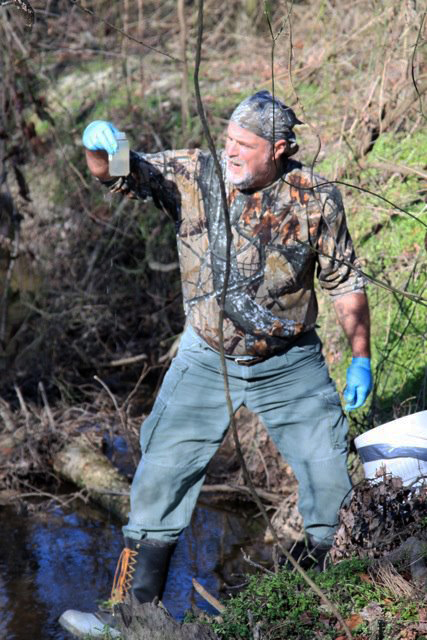
LARRY BALDWIN, NEW BERN
“I don’t have a job. I don’t have a career. I have a calling.”
Larry Baldwin went back to school fairly late in life to get a degree in environmental sciences. It was a chance meeting that took him straight to his calling — and to North Carolina and the waters of the Neuse.
The year was 2002, and the event was a panel discussion sponsored by the Chesapeake Bay Foundation. Panelists included Delaware Riverkeeper Maya van Rossum and former Neuse Riverkeeper Rick Dove.
“I asked Rick, how would one get involved in this, and he said there happened to be a position available in North Carolina. A month later, I was packing up my house in Hagerstown, Maryland, and moving to New Bern,” Baldwin laughed.
For nine years, Baldwin monitored the lower Neuse River and its tributaries, responding to complaints about construction in new developments clear-cutting beyond the buffers required at the time and reports of fish kills, which happened far more that they should have, Baldwin said.
“It became pretty clear the main issue was CAFOs. I became involved in that fairly quickly, but it was the typical issues: wastewater treatment plants, stormwater runoff,” he said.
On the job, he found resilience and perseverance were key, especially when it came to funding.
“There were times when we were like, ‘Wow, how are going to make it to the end the year? Or even the end of the month?’ But that’s not just our environmental organizations; it’s any nonprofit,” Baldwin said.
Though he had moved on by the time the Neuse Riverkeeper Foundation joined with Pamlico-Tar River Foundation to form Sound Rivers, he said the merger was a benefit to both organizations.
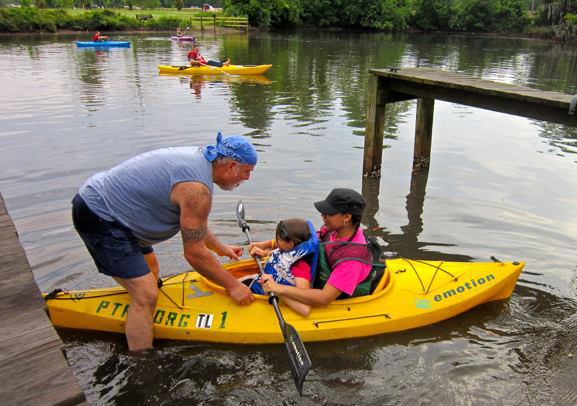
“If you look across the state, there are number of organizations, but it gives us the opportunity to combine a lot of the efforts. You also increase your numbers, and — in the work we do — a lot of our success is based on us being able to mobilize and engage the members that we do have. There were some very real commonalities between the two organizations, but now you have a bigger pool of people, of members and volunteers, to draw on, who are now all a part of the same family,” Baldwin said.
Now the Crystal Coast Waterkeeper with Coastal Carolina Riverwatch, Baldwin said the work of waterkeepers everywhere has not changed much over his years as a Riverkeeper.
“It’s not getting any easier. You would think in this day and age that, by now, people in general would know we cannot treat our planet the way we have and not have bad results,” he said. “There’s more political influence on what is happening to our water quality, and it’s getting worse, not better. Water doesn’t belong to one party or the other, and it certainly doesn’t belong to industry. I see more industry — big industrial, big ag, big pharmaceutical — having more influence on our water, with little regard to consequences that happen as a result. … We cannot keep treating our water resources as a commodity that can be bought and sold.”
When Baldwin thinks of the future, he thinks about his 3-year-old grandson, and wonders what that future will hold for the next generations, especially when it comes to clean water.
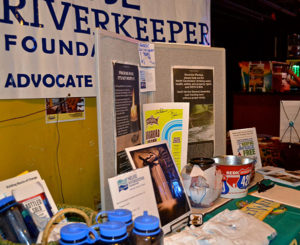
“Basically, what you’re seeing is the bad stuff every day. Sometimes you go home at end of the day and say, ‘What did I accomplish?’ Not everybody can do this job, because you have to put this job in perspective, even when you don’t always know what the perspective is,” Baldwin said. “I guess the really frustrating thing about this is we’re not learning from our mistakes. It’s almost like we’re using our mistakes to make excuses for more mistakes.”
Baldwin says perseverance is what kept the NRF and PTRF going, both separate and together as Sound Rivers, and that same perseverance keeps many Waterkeepers doing work that is often intangible.
“It’s not just about what we’ve accomplished — it’s about what we’ve prevented from happening,” Baldwin said. “It’s the most frustrating job I’ve ever loved.”
